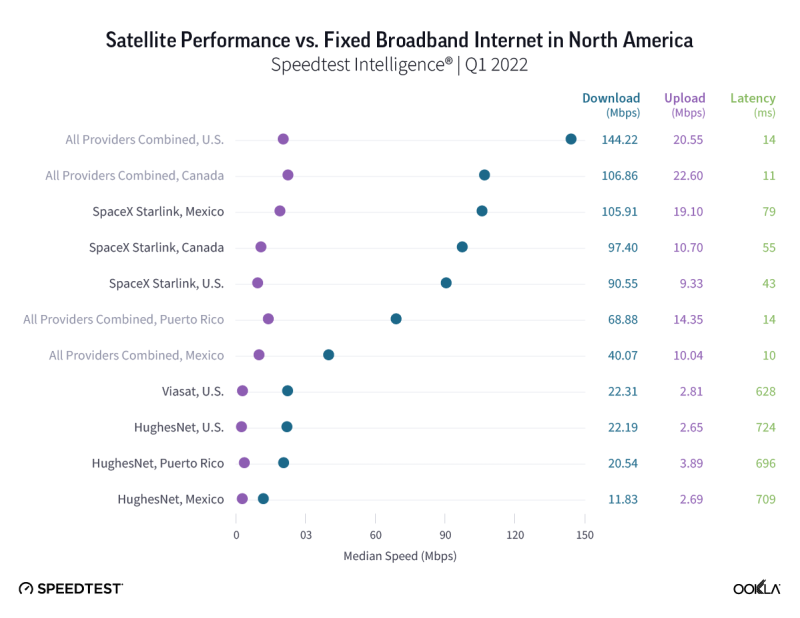SpaceX’s Starlink satellite internet speeds increased nearly 38% in the U.S. and 58% in Canada over the past year, according to the latest Speedtest data from Ookla.
Elon Musk’s Starlink first launched in public beta in November 2020 and has been gaining steam since. The company said in late May that its service now has over 400,000 subscribers around the world, and it's active in 48 U.S. states.
Starlink uses low earth orbit (LEO) satellites, which improve broadband speeds compared to earlier types of satellite internet because the signals don’t have to travel nearly as far back and forth between the satellites and earth. The downside is that because of the low-earth orbit angles, sometimes the signals can be blocked by terrain.
Ookla’s latest data shows how Starlink’s internet performance has changed over the past year. According to its Speedtest, median download speeds for Starlink dramatically increased from the first quarter of 2021 to the first quarter of 2022 in the U.S. and Canada, as did speeds for all fixed broadband providers combined.
Ookla said "all fixed broadband providers combined" incudes cable, fiber, DSL, etc.
In the U.S. Starlink median download speeds improved roughly 38% from 65.72 Mbps in Q1 2021 to 90.55 Mbps in Q1 2022. In Canada, Starlink’s download speed leapt ahead nearly 58% from 61.84 Mbps to 97.40 Mbps during the same time period.

However, Speedtest Intelligence also showed that upload speeds for Starlink decreased nearly 33% in the U.S. (16.29 Mbps in Q1 2021 to 9.33 Mbps in Q1 2022) and 23% in Canada (16.69 Mbps to 10.70 Mbps) during the same time period. Ookla wouldn't speculate why upload speeds decreased or why there was a slight dip in median speeds from Q4 2021 to Q1 2022.
Median latency on Starlink marginally increased from 40 ms to 43 ms in the U.S. and from 51 ms to 55 ms in Canada during the past year. “For many Starlink users, we suspect these changes are negligible,” wrote Ookla content specialist Josh Fomon, in a blog post.
Starlink in Mexico had the fastest satellite internet in North America during Q1 2022 with a median download speed of 105.91 Mbps, followed by Starlink in Canada (97.40 Mbps) and the U.S. (90.55 Mbps). Mexico’s fixed broadband download speed (40.07 Mbps) was much slower than Starlink, while Starlink download speeds were slower than fixed broadband for all providers combined in the U.S. (144.22 Mbps) and Canada (106.86 Mbps).

Puerto Rico showed HughesNet had the fastest satellite internet on the island territory at 20.54 Mbps, though fixed broadband was much faster at 68.88 Mbps.
“As we’ve continued to see over the past year, Starlink’s LEOs provide a life-changing service for consumers in rural areas that might not otherwise have access to high-speed internet,” wrote Fomon. “However, more companies are looking to compete with Starlink and launch their own LEO constellations, including Amazon’s Project Kuiper, which recently received FCC permission to test their own satellite service and is slated to launch later this year, and Viasat which is set to merge with Inmarsat and launch new constellations by 2023.